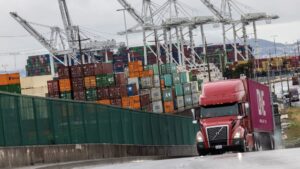Understanding the Impact of U.S. Tariffs on Economic Dynamics
At Extreme Investor Network, we delve deep into the intricacies of economic trends and their implications for investors. Today, we explore the significant spikes in U.S. tariff revenues and how they impact the broader economic landscape—an ongoing saga that could reshape investment strategies for many.
Record Tariff Revenues: A Turning Point?
Recently, U.S. tariffs hit a remarkable peak, generating $16.3 billion in customs duties just for the month of April. This represents an astonishing 86% increase compared to March’s collection of $8.75 billion and more than double the $7.1 billion collected during the same month last year. These figures illustrate the profound effects of trade policies initiated during the Trump administration, which included broad tariffs on imports.
But what does this mean for you as an investor?
A Fiscal Balancing Act
Even though the U.S. is grappling with a considerable budget deficit, the influx from tariffs provided a semblance of relief in April. Typically a month marked by surpluses due to income tax filings, the month saw a surplus of $258.4 billion—up 23% from the same period last year. However, it’s crucial to understand that this surplus only momentarily alleviates the ongoing fiscal challenges, with the year-to-date deficit climbing to $1.05 trillion, a staggering 13% increase year over year.
The Broader Economic Picture
In April, tariff revenues contributed to an overall increase in federal receipts by 10% compared to 2024, even as government outlays decreased by 4%. This juxtaposition gives a clearer view of a complicated fiscal landscape, where tariff collections provide a necessary buffer against escalating expenditures. Year to date, federal receipts have risen by 5%, while outlays swelled by 9%.
Interest Rates: The Hidden Challenge
It’s also vital to consider the effect of high-interest rates on federal finances. In April, net interest on the national debt soared to $89 billion, eclipsed only by Social Security expenditures. Over the fiscal year, net interest payments reached $579 billion, highlighting the urgent need for a robust fiscal strategy to manage the rising costs associated with national indebtedness, which stands at a towering $36.2 trillion.
Unique Insights for Investors
As an investor, understanding these shifts can help you navigate the complexities of the market. Here are some key takeaways to consider for your portfolio:
-
Sector Analysis: Examine sectors most affected by tariffs, such as manufacturing and retail. Companies reliant on imports might face increased costs, affecting their margins and stock prices.
-
Currency Fluctuations: Tariff policies can influence exchange rates. A weaker dollar can make U.S. exports cheaper, potentially benefiting exporters while raising costs for importers.
-
Interest Rate Trends: Keep an eye on the evolving interest rate landscape. Persistent high rates could lead to rising borrowing costs and economic slowdown, impacting your investment strategy.
- Long-Term Fiscal Policies: With the ongoing budget deficit and rising debt, stay informed on policy changes that could affect economic growth trajectories and, consequently, market performance.
Conclusion: The Investor’s Edge
In conclusion, the record revenues from tariffs provide a fascinating glimpse into the U.S. fiscal landscape amidst ongoing trade tensions. At Extreme Investor Network, we encourage our readers to stay informed and analyze these economic indicators critically. By understanding the implications of government policies on your investments, you can make more informed decisions in an ever-changing market.
Stay connected with us for more insights that empower your investment journey!

